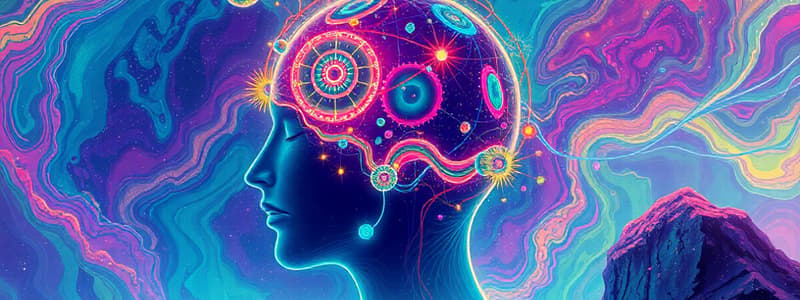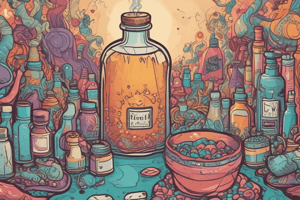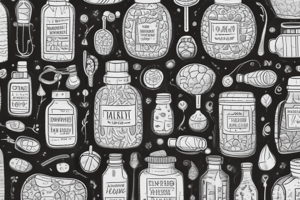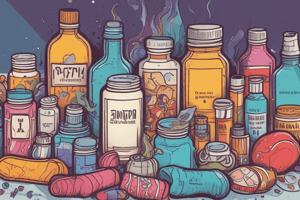Podcast
Questions and Answers
Which of the following best describes the primary effect of depressants on the central nervous system?
Which of the following best describes the primary effect of depressants on the central nervous system?
- Accelerating neural activity and cognitive function.
- Slowing down neural activity. (correct)
- Creating a sense of increased energy and alertness.
- Heightening sensory perception and awareness.
Which of these is the most accurate description of 'designer drugs'?
Which of these is the most accurate description of 'designer drugs'?
- Manufactured substances intended for recreational use, often derived from approved drugs to bypass legal restrictions. (correct)
- Drugs primarily designed for use in medical research and rarely available on the street.
- Illicit substances created to mimic therapeutic drugs but without any psychoactive effects.
- Substances primarily used in the fashion industry to enhance clothing and accessories.
What is the main purpose of drug treatment court programs?
What is the main purpose of drug treatment court programs?
- To provide an alternative to incarceration for drug-using offenders through rehabilitation and treatment. (correct)
- To exclusively punish drug-using offenders with long prison sentences.
- To offer job training to repeat offenders regardless of their substance abuse issues.
- To expedite the processing of drug-related cases through the court system without addressing underlying issues.
Which amendment to the U.S. Constitution initiated national Prohibition?
Which amendment to the U.S. Constitution initiated national Prohibition?
Which of the following is an example of 'eradication' as it relates to illegal drug production?
Which of the following is an example of 'eradication' as it relates to illegal drug production?
Which category of drugs is known for altering one's thought processes, mood, and perceptions?
Which category of drugs is known for altering one's thought processes, mood, and perceptions?
What is the primary goal of 'harm reduction' strategies in drug policy?
What is the primary goal of 'harm reduction' strategies in drug policy?
What was the main requirement of the Harrison Act?
What was the main requirement of the Harrison Act?
Heroin is best described as:
Heroin is best described as:
What is a defining characteristic of inhalants compared to other drug types?
What is a defining characteristic of inhalants compared to other drug types?
‘Interdiction’ in the context of drug control refers to:
‘Interdiction’ in the context of drug control refers to:
Which of the following best describes the 'maintenance' approach to drug policy?
Which of the following best describes the 'maintenance' approach to drug policy?
The Marihuana Tax Act primarily focused on:
The Marihuana Tax Act primarily focused on:
Which of the following effects on the body makes morphine one of the most effective drugs?
Which of the following effects on the body makes morphine one of the most effective drugs?
Oxycodone is classified as:
Oxycodone is classified as:
Which amendment repealed the 18th Amendment, ending the Prohibition era in the United States?
Which amendment repealed the 18th Amendment, ending the Prohibition era in the United States?
What are steroids primarily used for, medically?
What are steroids primarily used for, medically?
Which of the following identifies a substance that creates a sense of energy, alertness and talkativeness?
Which of the following identifies a substance that creates a sense of energy, alertness and talkativeness?
Tranquilizers are a type of:
Tranquilizers are a type of:
According to the tripartite conceptual framework, psychopharmacological violence refers to:
According to the tripartite conceptual framework, psychopharmacological violence refers to:
Which of the following best describes the policy of decriminalization?
Which of the following best describes the policy of decriminalization?
Which of the following best describes the effects of amphetamine?
Which of the following best describes the effects of amphetamine?
Which of the following is true of ethanol??
Which of the following is true of ethanol??
Which of the following occurs during binge drinking?
Which of the following occurs during binge drinking?
Which of the following is a sign of barbiturate use?
Which of the following is a sign of barbiturate use?
Why is a historical understanding of drug trends essential for appreciating current societal perspectives on substance use?
Why is a historical understanding of drug trends essential for appreciating current societal perspectives on substance use?
According to the Tripartite Conceptual Framework, which of the following scenarios best exemplifies economically compulsive violence related to substance use?
According to the Tripartite Conceptual Framework, which of the following scenarios best exemplifies economically compulsive violence related to substance use?
Which scenario most accurately reflects the dynamic and multifaceted relationship between substance use and crime?
Which scenario most accurately reflects the dynamic and multifaceted relationship between substance use and crime?
Considering the varying legal statuses of substances (legal, illegal, legal with prescription), what critical implication arises regarding the definition of 'drugs' and their relation to crime?
Considering the varying legal statuses of substances (legal, illegal, legal with prescription), what critical implication arises regarding the definition of 'drugs' and their relation to crime?
Which of the following best describes a systemic source of violence as explained by the Tripartite Conceptual Framework?
Which of the following best describes a systemic source of violence as explained by the Tripartite Conceptual Framework?
Based on the provided information, which of the following statements most accurately reflects the relationship between drug abuse and crime?
Based on the provided information, which of the following statements most accurately reflects the relationship between drug abuse and crime?
According to the study in Zahedan central prison, how does the abuse of opiate drugs such as opium affect the type of crime committed?
According to the study in Zahedan central prison, how does the abuse of opiate drugs such as opium affect the type of crime committed?
In the context of the Zahedan study, what is the primary implication of the finding that increased drug abuse is associated with a higher delinquency rate?
In the context of the Zahedan study, what is the primary implication of the finding that increased drug abuse is associated with a higher delinquency rate?
Based on the data from Australia and the United States, what general conclusion can be drawn regarding the prevalence of drug abuse among incarcerated populations?
Based on the data from Australia and the United States, what general conclusion can be drawn regarding the prevalence of drug abuse among incarcerated populations?
Considering the types of crimes associated with hallucinogenic drug abuse (hashish, methamphetamine, psychotropic pills) in the Zahedan study, which intervention strategy would be most effective in addressing this issue?
Considering the types of crimes associated with hallucinogenic drug abuse (hashish, methamphetamine, psychotropic pills) in the Zahedan study, which intervention strategy would be most effective in addressing this issue?
Which of the following best synthesizes the concept of the cycle of poverty, addiction, and crime, as described in the context?
Which of the following best synthesizes the concept of the cycle of poverty, addiction, and crime, as described in the context?
How might the age of addiction onset (average 20.77 years in the Zahedan study) influence the types of crimes committed by addicted prisoners?
How might the age of addiction onset (average 20.77 years in the Zahedan study) influence the types of crimes committed by addicted prisoners?
Given the prevalence of drug-related crimes among addicted prisoners, which strategy would be most effective in breaking the cycle of drug abuse and crime within the prison system?
Given the prevalence of drug-related crimes among addicted prisoners, which strategy would be most effective in breaking the cycle of drug abuse and crime within the prison system?
How do drug policies that prioritize punishment and incarceration align with or contradict the study's conclusions regarding the relationship between drug abuse and crime?
How do drug policies that prioritize punishment and incarceration align with or contradict the study's conclusions regarding the relationship between drug abuse and crime?
Flashcards
Alcohol (Ethanol)
Alcohol (Ethanol)
The only type of alcohol that is safe for consumption, rapidly absorbed into the bloodstream.
Amphetamine
Amphetamine
A stimulant with effects similar to cocaine, but has a slower onset and a longer duration.
Barbiturate
Barbiturate
A depressant that can cause a wide range of central nervous system depression, from sedation to coma.
Binge Drinking
Binge Drinking
Signup and view all the flashcards
Cannabis
Cannabis
Signup and view all the flashcards
Cocaine
Cocaine
Signup and view all the flashcards
Decriminalization
Decriminalization
Signup and view all the flashcards
Depressants
Depressants
Signup and view all the flashcards
Designer Drugs
Designer Drugs
Signup and view all the flashcards
Drug Treatment Court Programs
Drug Treatment Court Programs
Signup and view all the flashcards
Eighteenth Amendment
Eighteenth Amendment
Signup and view all the flashcards
Eradication
Eradication
Signup and view all the flashcards
Hallucinogens
Hallucinogens
Signup and view all the flashcards
Harm Reduction
Harm Reduction
Signup and view all the flashcards
Harrison Act
Harrison Act
Signup and view all the flashcards
Heroin
Heroin
Signup and view all the flashcards
Inhalants
Inhalants
Signup and view all the flashcards
Interdiction
Interdiction
Signup and view all the flashcards
Maintenance
Maintenance
Signup and view all the flashcards
Marihuana Tax Act
Marihuana Tax Act
Signup and view all the flashcards
Marijuana
Marijuana
Signup and view all the flashcards
Methamphetamine
Methamphetamine
Signup and view all the flashcards
Morphine
Morphine
Signup and view all the flashcards
Narcotics
Narcotics
Signup and view all the flashcards
Oxycodone
Oxycodone
Signup and view all the flashcards
Prohibition
Prohibition
Signup and view all the flashcards
Steroids
Steroids
Signup and view all the flashcards
Stimulant
Stimulant
Signup and view all the flashcards
Tranquilizers
Tranquilizers
Signup and view all the flashcards
Tripartite Conceptual Framework
Tripartite Conceptual Framework
Signup and view all the flashcards
Twenty-First Amendement
Twenty-First Amendement
Signup and view all the flashcards
War on Drugs
War on Drugs
Signup and view all the flashcards
Substance Use and Crime
Substance Use and Crime
Signup and view all the flashcards
Complexity of Drug Definitions
Complexity of Drug Definitions
Signup and view all the flashcards
Historical Trends of Substance Abuse
Historical Trends of Substance Abuse
Signup and view all the flashcards
Drug Abuse Among Male Prisoners (US, 2010)
Drug Abuse Among Male Prisoners (US, 2010)
Signup and view all the flashcards
Combined Drug and Alcohol Abuse
Combined Drug and Alcohol Abuse
Signup and view all the flashcards
Drug Abuse History Among Arrested Individuals (Australia, 2004)
Drug Abuse History Among Arrested Individuals (Australia, 2004)
Signup and view all the flashcards
Crimes of Opiate Abusers
Crimes of Opiate Abusers
Signup and view all the flashcards
Crimes of Hallucinogenic Drug Abusers
Crimes of Hallucinogenic Drug Abusers
Signup and view all the flashcards
Drug Abuse and Delinquency
Drug Abuse and Delinquency
Signup and view all the flashcards
The Cycle of Addiction and Crime
The Cycle of Addiction and Crime
Signup and view all the flashcards
Study Notes
- Understanding the complex relationship between substance use and crime requires considering individual, group, and societal factors.
- The very definition of "drugs" can be complex.
- Some drugs are legal but highly addictive, for example, nicotine.
- Certain drugs are legally prescribed for medical uses but can be abused illegally, such as OxyContin.
- Some drugs were initially legal but are now illegal, as seen with heroin.
- Examining substance abuse trends, like the history of cocaine and opioid addiction, Prohibition, and the "War on Drugs," is essential for appreciating current societal views on substance use.
- Some substances, such as alcohol, have transitioned from legal to illegal and back to legal status throughout history.
- The relationship between drugs and crime is more complex than a simple causal explanation.
Statistics Linking Drug Abuse to Crime
- In a 2010 United States study, 70% of male prisoners were drug abusers, significantly higher than the 11.2% rate in the general male population.
- Alcohol has the strongest correlation with aggressive crimes.
- 21.4% of aggressive crimes were committed by criminals who abused both drugs and alcohol.
- In Australia in 2004, 82% of arrested individuals had a history of drug abuse.
- Of those arrested in Australia, 69% abused drugs for at least six months before their arrest, and 62% were frequent drug abusers.
Study on Addicted Prisoners in Zahedan Central Prison
- A study examined the relationship between crime type and drug abuse among addicted male prisoners undergoing methadone maintenance treatment in Zahedan central prison.
- The study population consisted of 923 addicted male prisoners, all selected for the study.
- Data was collected through questionnaires and interviews and analyzed using SPSS 19 software.
- The study investigated demographic factors, addiction history, and the type of crime committed.
- The participants' average age was 33.84 years, with an average addiction age of 20.77 years and an involvement duration of 11.94 years; 69% were married, and 31% were single.
- Abused substances included Iranian crack, opium syrup, methamphetamine, heroin, psychotropic pills, and cannabis.
Crimes Associated with Opiate Abuse
- Opiate drug abusers (opium syrup, opium, heroin, and Iranian crack) were commonly involved in drug-related crimes, robbery, murder, armed robbery, and kidnapping.
- Drug-related crimes: crack (63.7%), heroin (52.4%), opium (43.8%), opium syrup (40.5%).
- Robbery: crack (63.3%), heroin (52.4%), opium syrup (22%), opium (21.6%).
- Murder: opium (21.6%), crack (18.30%), opium syrup (14.5%), heroin (9.7%).
- Armed robbery: heroin (25%), opium syrup (22%), crack (21.1%), opium (12.4%).
- Kidnapping: opium (4.3%), opium syrup (4.2%), crack (2.6%), heroin (2.4%).
Crimes Associated with Hallucinogenic Drug Abuse
- Hallucinogenic drug abusers (hashish, psychotropic pills, methamphetamine) were commonly involved in robbery, drug-related crimes, armed robbery, and murder.
- Robbery: methamphetamine (53.2%), pills (36.6%).
- Drug-related crimes: hashish (33.3%), methamphetamine (21.6%), pills (9.1%).
- Armed robbery: hashish (33.3%), pills (9.1%), methamphetamine (5.4%).
- Murder: pills (18.2%), hashish (16.7%), methamphetamine (8.8%).
Relationship Between Drug Abuse and Crime
- A direct relationship exists between the level of drug abuse, the type of drug, and the crimes committed.
- Increased drug abuse correlates with a higher delinquency rate and intensity. For addicts, they are often driven to commit crimes to get drugs due to lack of employment and income, leading to illegal activities like smuggling, drug dealing, theft, and prostitution.
- This creates a cycle of poverty, addiction, and crime.
- There is a need for developing preventive strategies.
Studying That Suits You
Use AI to generate personalized quizzes and flashcards to suit your learning preferences.




